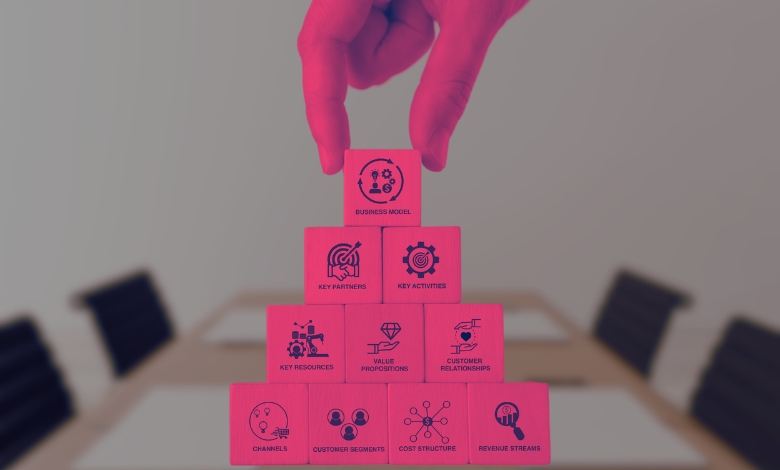We’ve clearly explained 13 types of business models that can really help your new startup succeed and choose the right path.
When you’re starting a company, you must pick how it makes money. That’s the business model. It shows how you create value, give it to customers, and earn cash. It’s essential. Your whole plan depends on it.
Regular business models won’t work as well now. Markets change quickly. New, creative models emerge. This article examines 13 startup business models. Understanding them helps you choose wisely for your company.
In this blog post, we’ll closely look at 13 different startup business models. Each has unique features and benefits. By learning about them, you can decide which fits best.
So let’s explore the exciting world of business models.
Article Breakdown
What is a Business Model?
A company’s business model acts like a map. It shows how the business makes money. It explains how the company works with customers, suppliers, and partners. A business model tells a company how to create value. It also explains how to deliver that value. It shows how to capture value as well.
Picking the right model is super important for startups’ success. A Harvard Business Review study found something amazing. Startups that adapt their business models to the market are 7 times more likely to profit long-term. They also grow long-term. Smart startups change and adjust based on market needs. This raises their chance of surviving. It also boosts profitability.
Business models come in all shapes and sizes. They are customized for different needs and markets. Some sell products directly to consumers. Others offer services through subscriptions. Each model has its own way to generate income. Certain businesses make money from advertisements. Others rely on franchise agreements to expand.
We’ve explored these 13 business models, think carefully. Decide which model works best for your needs.
| Business Model | Best For (Startups) |
| 1. Product or Service Sales | Traditional industries, Retail |
| 2. Subscription Model | Services with recurring value |
| 3. E-Commerce Model | Online retail, Direct-to-consumer |
| 4. Freemium Model | Digital products, Apps, SaaS |
| 5. Advertising Model | Content platforms, Media |
| 6. Affiliate Model | Niche markets, Influencers |
| 7. Pay-Per-Use Model | Usage-based services, Utilities |
| 8. Franchise Model | Expansion-minded businesses |
| 9. Marketplace Model | Multi-vendor platforms, E-commerce |
| 10. Platform as a Service (PaaS) Model | Tech startups, app developers |
| 11. Software as a Service (SaaS) Model | Cloud-based services, B2B solutions |
| 12. Licensing Model | IP owners, Creative industries |
| 13. Direct Sales/Door-to-Door Sales | Personal products, Local services |
1. The Traditional Business Model: Product or Service Sales
Selling products or services has always been crucial for startups. This model involves making something valuable that people need and want. Understanding your audience is key. Deliver what they desire, and you’ll earn money from direct sales.
Loyal customers and repeat business are vital. Treat customers well and ensure top-notch quality. Smart marketing is also essential to reach potential buyers and drive sales. In today’s competitive world, you must adapt. Follow trends, innovate, and keep improving to stay ahead of rivals.
2. Subscription Model
Subscriptions are popular for steady income. Customers pay regularly to access your product or service. This creates predictable revenue and long-term relationships. Steady income allows planning and investing in growth opportunities.
No more worrying about keeping up with payments. Automatic renewals give folks easy access to their favorite services. Subscription startups don’t need to chase customers down each time. Steady service builds loyalty.
Meal kits, streaming, you name it – subscriptions are everywhere nowadays. The key is giving consumers what they crave, with flexible plans. There’s something for every type of business.
3. E-Commerce Model
Selling stuff online? That’s e-commerce in a nutshell. Companies launch websites or use big platforms like Amazon. Whatever works for getting products to buyers. As tech keeps growing, so does e-commerce’s popularity. It lets startups easily ship their wares to anyone, anywhere.
Amazon, Alibaba, Etsy – those names ring any bells? E-commerce titans, all of them, thanks to this model.
4. Freemium Model
Ever encountered an app or service with free basic features, but requiring payment for upgrades? That’s the Freemium Model. It enables startups to attract users without initial cost, while prompting upgrades for additional benefits.
Offering a “freemium” version allows businesses to showcase value before requesting customer commitment. This tactic proves popular in the digital realm, where users expect trial opportunities prior to purchase.
Startups utilizing the freemium model must strike a careful balance: providing enough free value to retain users, while offering premium features compelling enough for payment. Successful implementation can lead to increased user adoption and revenue growth.
The freemium model has demonstrated effectiveness for startups seeking to expand their customer base and generate sustainable revenue streams.
5. Advertising Model
A startup seeking revenue generation? The advertising model could provide a solution. This involves offering free products or services to users, while earning income through third-party advertisements.
By strategically positioning ads on your platform, you can monetize user traffic and engagement levels. Whether display ads, sponsored content, or native advertising, various options exist within the advertising model.
The scalability of this approach is remarkable. As your users increase, so does potential ad income. Plus, advertisers seek platforms with high visibility and engagement, making this arrangement good for everybody.
Still, you must balance revenue and user experience. Too many disruptive ads can drive users away. So, carefully consider where ads are placed and how relevant they are for successful implementation.
The advertising model allows startups to leverage their audience reach into sustainable income streams without directly charging users for access to products or services.
6. Affiliate Model
Affiliate marketing is a business model popular with startups looking to generate revenue through partnerships with other businesses. Companies pay affiliates commission for driving traffic or sales to products/services.
Startups benefit by leveraging affiliates’ reach and influence to promote offerings. Affiliates earn passive income by promoting products they believe in.
A key advantage is low upfront costs for startups. Rather than investing in traditional advertising, they partner with affiliates paid only when delivering results.
For affiliates, this model offers flexibility and scalability – they choose products to promote and effort for each partnership. A win-win where both gain from effective collaboration.
7. Pay-Per-Use Model
The Pay-Per-Use Model is an innovative business approach. Customers only pay for the service when they use it. This allows users to access products or services on-demand, paying only for the amount consumed. It’s a flexible and cost-effective solution.
For startups, the Pay-Per-Use Model is game-changing. By eliminating upfront fees and subscriptions, it appeals to pay-as-you-go customers. Whether cloud services, transportation, or software applications, costs align with usage. It’s a win-win solution.
Consumers benefit from affordability and convenience. Businesses attract wider customer bases. Its transparent pricing and scalability reshape industries, enabling accessible services.
8. Franchise Model
The franchise model allows startups to expand reach. It involves granting individuals/groups rights to operate under an established brand and business model. Franchisees benefit from proven success, reducing new venture risks.
For entrepreneurs considering franchising, it offers ready operations and marketing blueprints. Franchise owners tap into existing customer bases and collective advertising at local and national levels. This can drive faster growth and higher success chances versus going solo.
It’s very important for potential franchisees to do their research. Thoroughly understand the agreement’s terms before signing on the dotted line. Franchises offer support systems, sure. They also bring brand recognition – that’s valuable. But don’t overlook the financial commitments and operational guidelines. You must follow those closely. With diligent planning and consistent execution, franchising rewards startups seeking growth.
9. Marketplace Model
Have you pondered starting a business connecting buyers and sellers online? The Marketplace Model suits startups aiming to facilitate multi-party transactions perfectly. This model allows you to create a virtual space for buying and selling products/services conveniently.
Bringing diverse vendors onto one platform is key. Customers enjoy a wide variety – they have lots of options. Sellers face healthy competition, leading to attractive pricing and consumer savings. Plus, small businesses/individual sellers access a broader audience minus pricey ecommerce websites.
Marketplace platforms make money through transaction fees or commissions on sales facilitated. This incentivizes driving traffic and boosting sellers’ sales volumes. E-commerce’s rise proves this model’s success across retail, hospitality, freelancing, and beyond.
The Marketplace Model is an interesting chance for new businesses. It lets them make some cool online marketplaces. This goes against the old way stores used to do things. The marketplaces can give people what they want these days.
10. Platform as a Service (PaaS) Model
PaaS is a digital space. Apps are built and launched, without infrastructure worries. Startups focus on innovation while providing hardware management. PaaS offers a playground for software solutions.
Envision access to tools and resources needed for idea realization. The platform gives scalability, flexibility, cost-efficiency. It streamlines development for mobile apps, websites, custom software. PaaS lays a strong base for startup growth, offering new services.
Using PaaS accelerates time-to-market and market adaptability. Integration of third-party resources enhances capabilities further. In a fast economy, PaaS gives startups an edge by allowing focus on innovation over infrastructure tasks.
11. Software as a Service (SaaS) Model
Startups offering software minus physical products? SaaS is the solution – software applications delivered via subscription service. No hassle of tangible goods involved.
Software as a Service (SaaS) is an innovative model. Users don’t need expensive installations or updates. They access the software over the internet. This model is flexible and scalable. It’s perfect for startups with changing needs.
By offering SaaS, startups reach a wider audience. They cater to diverse market segments. The pay-as-you-go pricing appeals to customers. It’s a cost-effective solution.
Additionally, SaaS providers continuously improve offerings. Users feedback and data analytics guide this iterative process. The software stays relevant and competitive. It adapts to today’s fast-paced market.
Adopting the SaaS model paves the way for startup success. Convenience and efficiency are key factors in the digital landscape. And this model delivers.
12. Licensing Model
The licensing model is strategic. It allows startups to generate revenue. They grant other businesses permission to use intellectual property. This includes patents, trademarks, or copyrights. The licensor expands reach and monetizes creations. They don’t directly manufacture or sell products.
By licensing technology or brand, startups tap into new markets. They benefit from established companies’ expertise in those industries. This collaboration increases brand visibility and credibility. It fosters potential for long-term partnerships.
Startups using this model carefully negotiate agreements. Terms outline use, royalties, and intellectual property rights protection. Both parties clearly understand expectations and responsibilities. This understanding is crucial throughout the partnership.
Permitting startups greater room for development, the licensing model facilitates generating revenues via collaborations beneficial for all parties involved, through leveraging innovations flexibly.
13. Direct Sales/Door-to-Door Sales
Where individuals market and sell goods or services directly at consumers’ residences is direct sales, also named door-to-door sales. The model depends on interpersonal abilities and persuasion to finalize purchases.
This approach creates chances to connect with clients personally, providing more tailored experiences compared to distant methods. Direct selling can be advantageous for offerings requiring hands-on demonstrations or detailed explanations.
Despite seeming outdated in our digital era, when conducted effectively, it remains viable. It allows capturing buyer feedback instantly and addressing concerns immediately. For fledgling enterprises wanting loyal clientele and quick income, door-to-door selling is a strategy worth considering. However, dedication, persistence, and solid communication proficiency are essential for excelling in this competitive field.
Final Words
Not a single universal perfect model exists. Startups must contemplate their target demographic, industry, and objectives before choosing—be it the popular Marketplace Model for e-commerce, PaaS and SaaS for tech ventures, licensing for those owning valuable intellectual property, or direct sales fostering personal consumer bonds. Continually reassessing and adapting the chosen approach is crucial, coupled with tenacity, resilience, and strategic planning. Success and positive impact are achievable through embracing risks and entrepreneurial possibilities. This signifies merely the start of building a thriving enterprise. Ongoing learning, growth, and innovation are pivotal, alongside unwavering passion for making a difference via one’s concepts and creations.



